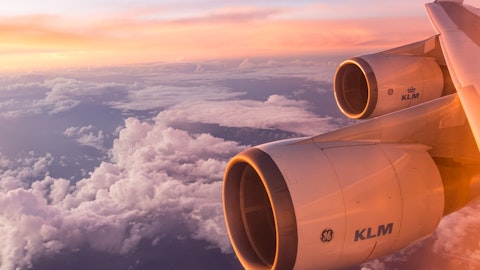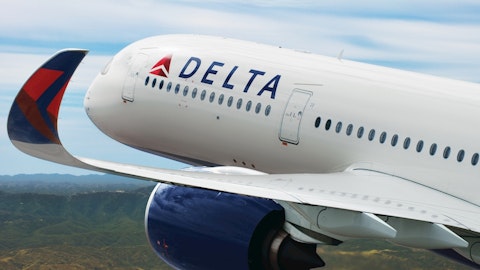Vasu Raja: This is Vasu. I’m happy to, although 5 years’ time in this business, as you know well, is like an eternity you go. And so really, probably the more factually relevant thing is what it is year-over-year. And so yes, 61% of our revenue is coming from premium content. It is the revenue driver of the airline. That revenue is up 17% year-over-year. It’s close to a 10-point shift in mix from nonpremium content. And it’s a little difficult to compare versus 5 years ago because you look at numbers, which can be sometimes stratospherically high. And that really relates to just a different time and place for where our customers were, where the industry was and frankly, where the technology today is. But this growth in premium content is something which is really encouraging to us because it certainly corroborates the point that customers value experiences and they’re willing to spend on experiences, and we’re pleased that we see that growth pretty much across channels and maybe if anything more so through our direct channels.
Robert Isom: And Vasu, I would add that, that’s a critical component of our distribution strategy as well. We absolutely positively must make sure that our customers, no matter where they interact with us, have the full access to the goods services, amenities that American can offer. That’s the key for us going forward. So I like what we see in terms of trends, we’re going to pursue more of it. And then from that perspective, from a technology basis, we now are at a point where 95% of all transactions that customers have with us can be digitally serviced. So this is a coordinated effort across everything that we’re doing. And as Vasu said earlier as well, we’ll make adjustments along the way. This is about win in the long run. But in the short run, we’ve got to make tactical adjustments and we’re doing that.
Stephen Trent: Super helpful. I was thinking broadly about the big transformation versus pre-pandemic, but that’s great. Just one other quick one for me. When I think about the regional fleet and your relationship with Embraer, hypothetically is larger OEMs continue to stumble in terms of delivery. Would it be too wild to think under certain scenarios that you would consider the largest gauge Embraer aircraft for some mainline flying? Or it’s just that — that’s just too wild an idea from the scope less perspective and what have you.
Robert Isom: All right. Well, I like that question because it gives me a chance to give a shout out. We all hear in the supply chain of partners or vendors that have really not recovered through the pandemic very well. We all know those names. But I want to give a shout out to Embraer. They have delivered day in and day out to that the pandemic, no matter the concerns of their supply chain. The rest of the industry and our OEM is going to learn a lot from them.
So I’m proud to be the operator of the world’s largest fleet of Embraer aircraft. And I’m also proud to have an order book that’s larger than anybody else as well. So we are tied to Embraer. Now that aircraft that we use today, the E175 ideally suited to our regional network and it’s also ideally suited for the constraints that we have in terms of the mix between our mainline and regional flying.
So as we look forward, I feel really good about the fleet plan that we have, I don’t know about new offerings. But for the time being, our narrow-body fleet and what we have projected our wide-body fleet, we’re in pretty good shape on aircraft through the end of the decade.
Operator: Our next question comes from the line of Helane Becker of TD Cowen.
Helane Becker: So I have 2 questions. One, is, can you discuss any progress or lack thereof on your flight attendant contract? And I think how would that change the comment Devon made about reducing costs and the focus on cost reduction? And then my other very unrelated question is, how has the GOL bankruptcy affected your Latin and South American operations, positively or negatively?
Robert Isom: Thanks, Helane. I’ll take the flight attendant question. We’ve had a philosophy at American where we are going to pay our teammates at the best in the industry. And we’ve been really successful in negotiating contracts with most recently with our pilots or dispatchers and most — I guess, most, most recently was with our agents. And we’re really pleased that they’re paid at the top of the industry. That is the exact same philosophy that we have with our flight attendants. It’s what we pursued throughout negotiations. That’s been the basis of every offer that we’ve had on the table.
And of course, there have been movements in the industry and the top of the market, most notably by the recent pay increases that we’ve been made aware of at Delta and our flight attendants will benefit accordingly. And I really look forward to this being the basis for us getting to a deal. I’m very optimistic about that. And then in regard to how that would possibly impact our financials going forward, of course, we’ve identified that this will be something we’ll do this year. Devon can give you more insight on how that flows through our forecast.
Devon May: Helane, we’ve always planned for an increase for our flight attendants to pay them at the top of the industry. And with the new delta rates, we’ll obviously go and seek to match those rates. So it’s a little bit of an increase from where we were adding guidance, but even with that, we still expect to be inside of our full year CASM guidance.
And how it affects what you call our cost savings initiatives just these are initiatives where we are reengineering the business. So we are finding efficiencies throughout our business by utilizing technology better, through improved asset utilization and also through driving real procurement savings.
So we’ve always expected these types of increases for our team members, but it doesn’t interrupt anything we’re trying to do to reengineer the business.
Robert Isom: We don’t have the deal done yet, but we’re going to get back to the table. So Vasu, you want to talk about GOL?




